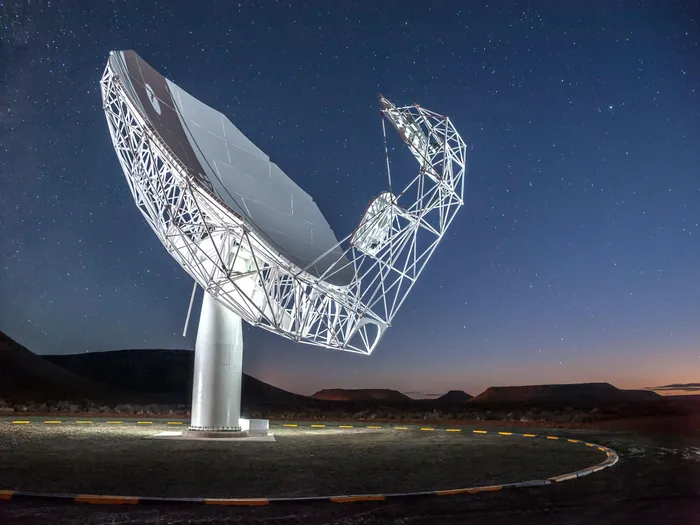Unveiling the secrets of 3I/ATLAS: South African scientists confirm comet-like behaviour
CELESTIAL VISITOR

One of the 64 MeerKAT Telescopes observing our skies. An international research team has made significant strides in understanding the interstellar object known as 3I/ATLAS which is passing through our solar system.
Image: UWC
Since its discovery on July 1 by the Asteroid Terrestrial-impact Last Alert System (ATLAS), the interstellar object known as 3I/ATLAS has ignited fascination around the globe, marking only the third confirmed case of an object from beyond our solar system passing through. Speculation has run rampant over its origins, including thrilling theories of possible extra-solar artefacts. Now, an esteemed international research team, featuring prominent scientists from South Africa and Sweden, has made significant strides in understanding this celestial visitor, using the state-of-the-art MeerKAT radio telescope situated in South Africa.
Traditionally, comets made predominantly of water ice exhibit distinct signatures detectable by radio telescopes – the hydroxyl maser. As a comet approaches the Sun, the heat drives off ice, resulting in solar ultraviolet light splitting the water into hydrogen and hydroxyl molecules. This process can be monitored through specific radio signals emitted or absorbed at precise frequencies, well within the operational scope of MeerKAT, which is operated by the South African Radio Astronomy Observatory, which is a facility of the National Research Foundation, an agency of the Department of Science, Technology and Innovation. The detection process relies on various conditions regarding the comet's velocity and proximity to the Sun, making observing these signals both critical and complex.
3I/ATLAS, estimated to be a few hundred metres up to several kilometres in diameter, has remained relatively distant from the Sun during its transit, leading scientists to anticipate a weaker signal. Nevertheless, the MeerKAT telescope stands out as the most sensitive and versatile instrument available for this task. It has the unique ability to observe regions near the Sun where traditional optical telescopes fail, hitting the sweet spot where hydroxyl production is expected to peak. Furthermore, MeerKAT is enhanced with the BLUSE instrumentation from the Breakthrough Listen project, which diligently searches for technosignatures — signature signals indicative of technological origins.
Initial observations on September 20 and 28 offered no signs of hydroxyl. However, a breakthrough occurred on October 24, when the team successfully detected hydroxyl absorption from 3I/ATLAS at a distance exceeding 350 million kilometres from Earth, specifically identifying the hydroxyl masers in the 1665 and 1667 MHz transitions. Experts confirmed the results from follow-up observations on November 4 and 6, culminating in emission detection on November 11-12 — the team’s predictions proving accurate. “Detecting the hydroxyl signal is an important confirmation that 3I/ATLAS is behaving like a comet,” stated Professor Mykola Ivchenko from KTH Sweden.

This image from NASA shows the fast-moving interstellar object 3I/ATLAS that has got many to wonder about alien encounters that have been reported over the years.
Image: Supplied / NASA
Simultaneously, the Breakthrough Listen team rigorously analysed the data captured from the observations on November 5, concluding that no narrowband signals suggesting alien technology were detected from the direction of 3I/ATLAS. Given the considerable distance at that time, this indicates a power limit of 0.17 W — which is notably lower than typical emissions from everyday devices like cellphones, suggesting that MeerKAT is sensitive enough to detect a cellphone signal from hundreds of millions of kilometres away.
Ultimately, the observations from MeerKAT confirm that 3I/ATLAS is functioning like a comet, dispelling the potential for technological signals from the object. “We’re happy that we are contributing, alongside colleagues around the world, to a fuller understanding of this remarkable natural phenomenon — a comet likely formed in another stellar system that is briefly passing through our own,” remarked Fernando Camilo, Chief Scientist at SARAO.
The research was led by Professor DJ Pisano from the University of Cape Town, together with Distinguished Professor Oleg Smirnov (Rhodes University and SARAO), Sarah Buchner (SARAO), Professor Mykola Ivchenko and Dr Lorenz Roth (KTH Royal Institute of Technology, Sweden), and Dr Chenoa Tremblay (SETI Institute / Breakthrough Listen), encompassing the efforts of the dedicated SARAO and Breakthrough Listen teams.
“MeerKAT’s sensitivity gave us a unique view of this object at a time when it was more than 350 million kilometres from Earth,” said Pisano, adding “This is an extraordinary demonstration of South Africa’s world-leading scientific capability. MeerKAT allowed us to rule out even the faintest technological signal and confirm that 3I/ATLAS is a natural object. It’s a strong example of how UCT researchers and our collaborators contribute to global efforts to understand our cosmic environment.”
SARAO chief scientist Dr Fernando Camilo added: “We’re happy that we are contributing, alongside colleagues around the world, to a fuller understanding of this remarkable natural phenomenon – a comet likely formed in another stellar system that is briefly passing through our own.”
IOS